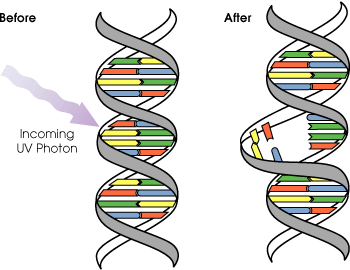It is important to distinguish between DNA damage and mutation, the two major types of error in DNA. DNA damages and mutation are fundamentally different. Damages are physical abnormalities in the DNA, such as single and double strand breaks, 8-hydroxydeoxyguanosine residues and polycyclic aromatic hydrocarbon adducts. DNA damages can be recognized by enzymes, and thus they can be correctly repaired if redundant information, such as the undamaged sequence in the complementary DNA strand or in a homologous chromosome, is available for copying. If a cell retains DNA damage, transcription of a gene can be prevented and thus translation into a protein will also be blocked. Replication may also be blocked and/or the cell may die
In contrast to DNA damage, a mutation is a change in the base sequence of the DNA. A mutation cannot be recognized by enzymes once the base change is present in both DNA strands, and thus a mutation cannot be repaired. At the cellular level, mutations can cause alterations in protein function and regulation. Mutations are replicated when the cell replicates. In a population of cells, mutant cells will increase or decrease in frequency according to the effects of the mutation on the ability of the cell to survive and reproduce. Although distinctly different from each other, DNA damages and mutations are related because DNA damages often cause errors of DNA synthesis during replication or repair and these errors are a major source of mutation
Given these properties of DNA damage and mutation, it can be seen that DNA damages are a special problem in non-dividing or slowly dividing cells, where unprepared damages will tend to accumulate over time. On the other hand, in rapidly dividing cells, unprepared DNA damages that do not kill the cell by blocking replication will tend to cause replication errors and thus mutation. The great majority of mutations that are not neutral in their effect are deleterious to a cell’s survival. Thus, in a population of cells comprising a tissue with replicating cells, mutant cells will tend to be lost. However infrequent mutations that provide a survival advantage will tend to clonally expand at the expense of neighboring cells in the tissue. This advantage to the cell is disadvantageous to the whole organism, because such mutant cells can give rise to cancer. Thus DNA damages in frequently dividing cells, because they give rise to mutations, are a prominent cause of cancer. In contrast, DNA damages in infrequently dividing cells are likely a prominent cause of aging.

No comments:
Post a Comment